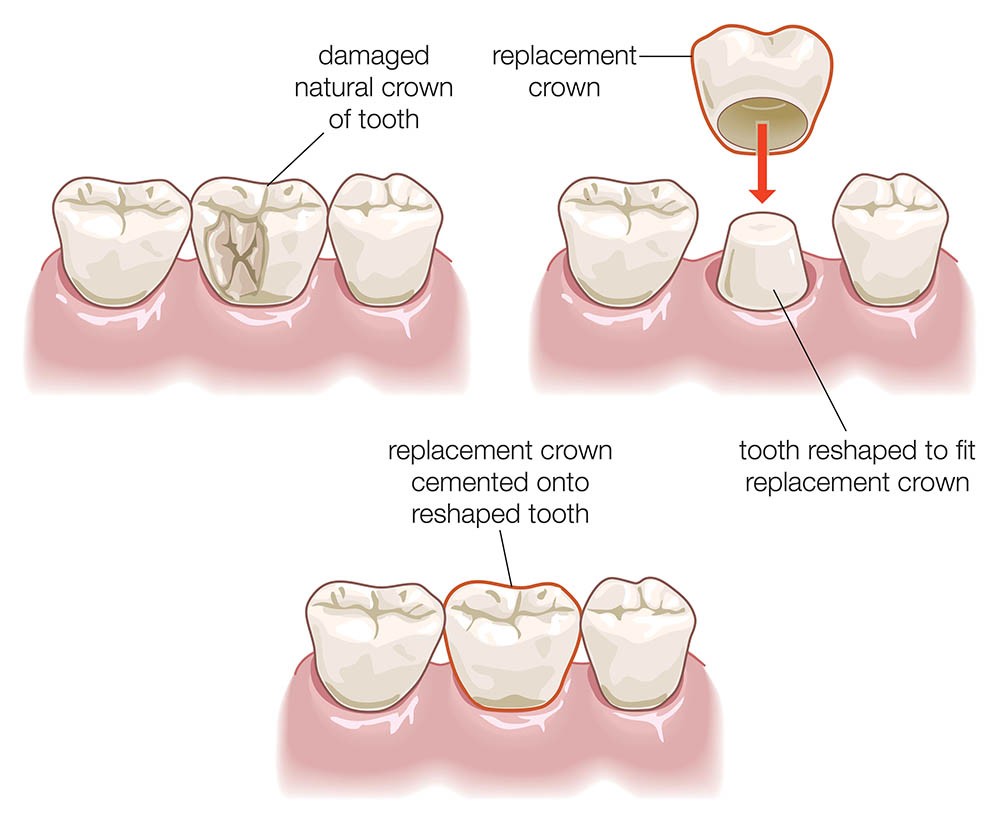Dental crowns, often referred to as tooth caps, are custom-made coverings that fit over a damaged, decayed, or misshapen tooth to restore its shape, size, strength, and appearance. Functioning much like a helmet for your tooth, a dental crown can be a crucial restorative treatment to protect and preserve your natural teeth. This guide will delve into what dental crowns are, why they’re needed, the procedure involved, and how to care for them, providing you with a comprehensive understanding of this common dental solution.
Understanding Dental Crowns: Restoring Your Smile and Functionality
A dental crown is essentially a tooth-shaped cap that is placed over a tooth that is extensively damaged or weakened. When cemented into place, the crown fully encases the entire visible portion of a tooth that lies at and above the gum line. They are designed to mimic the natural look and feel of your teeth, and are indispensable in various scenarios where a simple filling isn’t sufficient.
Why You Might Need a Dental Crown: Common Scenarios
Dental crowns are recommended for a variety of dental issues. Your dentist might suggest a dental crown if you are experiencing any of the following:
- Severely Decayed Teeth: When tooth decay is too extensive for a filling, a crown can protect the remaining tooth structure.
- Cracked or Broken Teeth: Crowns offer structural support to cracked or broken teeth, preventing further damage and restoring functionality.
- Post Root Canal Treatment: After root canal therapy, a tooth can become brittle. A crown is often necessary to protect and strengthen the treated tooth.
- Weak Teeth: To reinforce weak teeth and prevent them from fracturing.
- Cosmetic Enhancements: Crowns can cover severely stained, discolored, or misshapen teeth, improving your smile’s aesthetics.
- Supporting Dental Bridges: Crowns can serve as anchors to hold a dental bridge in place, replacing missing teeth.
- Securing Dentures: In some cases, crowns can help improve the fit and retention of partial dentures.
The Dental Crown Procedure: What to Expect
Getting a dental crown typically involves one or two visits to your dentist. Here’s a breakdown of what you can expect during the process:
Your First Visit: Tooth Preparation and Impression
During your initial appointment, the dentist will first examine the tooth that needs a crown and the surrounding teeth to ensure a crown is the most suitable solution. Once confirmed, the procedure begins with numbing the tooth and surrounding gum tissue with a local anesthetic. This ensures a pain-free experience throughout the process.
Next, the tooth is prepared by carefully reshaping it to create space for the crown to fit properly. The amount of tooth removed depends on the type of crown being used. Generally, a layer of the outer surface is removed to ensure the crown sits flush with your other teeth and bite.
After reshaping, an impression, or mold, of your tooth is taken. This can be done using a putty-like material or through digital scanning. This precise impression is crucial as it serves as the model for creating your custom crown in a dental laboratory. The lab technicians will use this impression to fabricate a crown that perfectly fits your tooth and bite.
In some cases, if the crown is being made using CEREC (Chairside Economical Restoration of Esthetic Ceramics) technology, the crown can be designed, milled, and fitted in a single visit using digital impressions and on-site milling equipment.
Finally, a temporary crown is placed on your prepared tooth to protect it while your permanent crown is being fabricated in the dental lab. This temporary crown is typically made of acrylic or stainless steel and is fitted using temporary cement.
Your Second Visit: Crown Fitting and Cementation
Once your permanent crown is ready (usually in about 2 to 3 weeks), you will return for your second appointment. The dentist will first remove the temporary crown and thoroughly clean the prepared tooth.
The permanent crown is then carefully placed over the tooth to check for fit, shape, and color match with your adjacent teeth. Adjustments may be made at this stage to ensure a perfect fit and comfortable bite.
Once the fit is satisfactory, the crown is permanently cemented onto your tooth using a strong dental adhesive or cement. The dentist will ensure the crown is securely in place and will clean off any excess cement.
 Illustration of a dental crown procedure.
Illustration of a dental crown procedure.
Caring for Your Dental Crown: Maintaining Longevity
While dental crowns themselves cannot decay, the tooth underneath and the gum line around the crown are still susceptible to decay and gum disease. Therefore, proper oral hygiene is crucial for maintaining the health and longevity of your dental crown.
- Brush Regularly: Brush your teeth at least twice a day with fluoride toothpaste and a soft-bristled toothbrush. Pay special attention to the area around the crown where it meets the gum line.
- Floss Daily: Floss daily to remove plaque and food particles from between your teeth and around the crown.
- Regular Dental Check-ups: Continue to visit your dentist for regular check-ups and professional cleanings. Your dentist can monitor the condition of your crown and the underlying tooth and gums.
- Avoid Hard and Sticky Foods: While crowns are strong, avoid chewing on extremely hard foods or sticky candies that could potentially damage or dislodge your crown.
Benefits and Potential Downsides of Dental Crowns
Dental crowns offer numerous benefits in restoring and protecting damaged teeth, but like any dental procedure, they also come with potential risks.
Advantages of Dental Crowns:
- Tooth Protection: Crowns effectively protect weakened teeth from further damage or fracture.
- Restored Functionality: They restore the tooth’s ability to chew and speak properly.
- Improved Aesthetics: Crowns can dramatically improve the appearance of stained, misshapen, or damaged teeth, enhancing your smile.
- Durability: With proper care, dental crowns can last for many years, often 10 to 15 years or even longer.
Potential Risks and Complications:
- Sensitivity: You may experience temporary tooth sensitivity to hot and cold temperatures after getting a crown.
- Chipped or Broken Crowns: Although rare, crowns can chip or fracture, especially porcelain crowns.
- Crown Loosening or Falling Off: The cement can sometimes wash out, causing the crown to loosen or come off. This can be due to decay underneath the crown or insufficient cement.
- Allergic Reactions: Rarely, some individuals may have allergic reactions to the materials used in crowns, particularly metal alloys.
- Gum Disease: If the crown margin is not properly fitted at the gum line, it can lead to gum irritation and increase the risk of gum disease.
Exploring Alternatives to Dental Crowns
Depending on your specific dental situation, there might be alternatives to dental crowns. These include:
- Dental Fillings: Suitable for smaller cavities and less extensive tooth damage.
- Dental Veneers: Thin shells placed over the front surface of teeth, primarily for cosmetic improvements, but not suitable for extensively damaged teeth.
- Dental Bridges: Used to replace missing teeth, anchored by adjacent teeth, often involving crowns on the anchor teeth.
- Dentures (Partial or Complete): Removable appliances to replace multiple or all missing teeth.
- Inlays and Onlays: More conservative restorations than crowns, used for moderate tooth damage, restoring the biting surface of teeth.
Conclusion:
Dental crowns are a versatile and effective solution for restoring and protecting damaged teeth. They offer a blend of functionality and aesthetics, helping you regain a healthy and confident smile. While they involve a procedure and require diligent aftercare, the benefits of dental crowns in preserving your natural teeth and improving your oral health are significant. If you think you might need a dental crown, consult with your dentist to discuss your options and determine the best course of action for your specific needs.
